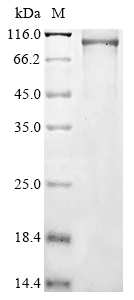The recombinant human 1-phosphatidylinositol 4,5-bisphosphate phosphodiesterase delta-3 (PLCD3) is generated using a baculovirus expression system. The transfer plasmid contains the full-length human PLCD3 protein, spanning amino acids 1 to 789, and incorporates a C-terminal 6xHis-tag for efficient purification. Insect cells are co-infected with the transfer plasmid and baculovirus DNA construct, resulting in the formation of the recombinant baculovirus particles. In the production process, insect cells are infected with the recombinant baculovirus carrying the PLCD3 expression construct. Within the infected insect cells, the recombinant PLCD3 protein is synthesized, allowing for proper folding and post-translational modifications. Following purification, the recombinant PLCD3 protein demonstrates purity of up to 85% as determined by SDS-PAGE analysis. On the gel, the PLCD3 protein appears as a distinct band with an approximate molecular weight of 96 kDa.
As a phosphodiesterase enzyme, PLCD3 selectively cleaves the phosphodiester bond in PIP2 molecules, generating two essential intracellular messengers: IP3 and DAG. IP3 triggers calcium release from intracellular stores, leading to diverse cellular responses, while DAG activates PKC, modulating downstream signaling pathways involved in cell growth, differentiation, and metabolism.






